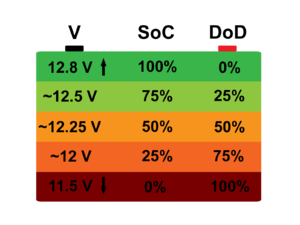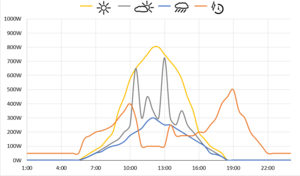Energy storage
PV systems produce energy when the sun is shining, but their production varies significantly depending on the season and whether it is cloudy or raining. There is also the inevitable reality of the sun setting each day. Variable production requires energy storage to provide a stable energy source and voltage when the PV source is not producing power to meet the energy demand. The most common form of storage in off-grid applications is batteries. Rechargeable batteries rely on chemical reactions to release energy when it is needed, but that can be run in reverse when the battery is being charged to store energy. There are many different types and sizes of batteries in the market. This is the case because there is no single type of battery that is superior in all applications. Each type of battery has uses different combinations of materials that have different advantages and disadvantages. All battery designs inevitably have to balance the following characteristics:
- Cycle life (life span)
- Cost
- Specific energy (energy capacity relative to size)
- Specific power (power capacity relative to size)
- Safety
- Performance under variable conditions
- Maintenance
A battery may have a long-life span and be able to handle large loads, but it will have large and heavy or cost too much. A battery may be able to supply lots of power and be relatively small in size, but it will not have a long lifespan. A battery must therefore be chosen based upon the particular application. One type of battery will be appropriate for a portable radio and another type will be appropriate for storage in a PV system. Small-scale PV systems with batteries typically rely upon lead acid batteries as they are a good compromise between all of these different factors.
Every type of battery has specific conditions for use that must be followed. It is very important to read the user manual and specifications sheet for any battery being considered to make sure that it will be appropriate for its intended use. Failure to choose the right battery or failure to use it properly can damage equipment or cause injury.
The energy storage system for an off-grid system must will be sized and selected based upon the load evaluation for a particular site - see Energy storage sizing and selection for more information.
Contents
Characteristics of batteries
The three most important characteristics when choosing a battery are:
Voltage
Batteries are rated with a nominal voltage (Vn). This voltage is called a nominal voltage as the voltage of batteries constantly varies depending on if they are being charged/discharged, their state of charge and the cell temperature.
Storage capacity
The energy storage capacity of a battery will be rated in amp-hours (Ah). or watt-hours (Wh). 1 amp-hour is equal to 1 amp of current transferred during the course of an hour, which is the standard rating method used for lead acid batteries. In the PV sector it is becoming more common to rate batteries in watt-hours because it is easier to understand the total storage capacity of an energy storage system. To be able to compare the storage capacity of a system to the potential loads it is necessary to convert from amp-hours to watt-hours. The formula is simple:
| Storage capacity | = ampere-hours (Ah) × nominal voltage (Vn) |
|---|
Example 1: There is a 12 V 120 Ah battery. What is the capacity of the battery?
- Storage capacity = 12 V × 120 Ah
- Storage capacity = 1440 Wh
Example 2: There are two batteries connected together that are each 12 V and 60 Ah. What is the capacity of the battery bank?
- Storage capacity = 12 V × 60 Ah × 2 batteries
- Storage capacity = 1440 Wh
Cycle life
Cycle life is the number of charge and discharge cycles that an energy storage device can provide before performance decreases to an extent that it cannot perform as required. The cycle life, or longevity, of all batteries depends upon the following factors:
Using batteries
The life of a battery is greatly affecting by how it is charged, discharged, maintained and under what conditions it is used.
State of charge (SoC)
The state of charge (Soc) of a battery is the total amount of its storage capacity that remains available for use. It is important for system users to understand how much energy remains for use to avoid damaging the battery by withdrawing too much energy. For example, if 25% of the capacity of a battery has been used, then its state of charge will be 75%. A fully charged 12 V AGM battery will have a voltage of around 12.8 V and empty it will have a voltage of around 10.5 V. If a battery is being discharged, its voltage will drop and if it is being charged its voltage will increase. In a PV system, which is constantly being charged and discharged, this can make it difficult to get a proper state of charge measurement from voltage. Nonetheless, users of many small-scale battery-based systems have no other option but to use the voltage of the sysetm as a guide. To get an accurate measurement of state of charge there are three options:

- The ideal method to measure the state of charge of a battery is to use a device called a shunt. A shunt is a device that can measure the amount of current flowing in and out of battery to estimate its available capacity.
- Disconnecting all of the loads and charging sources and then waiting three hours to let the voltage stabilize.
- The state of charge of a flooded lead acid battery can be taken using a specialized device called a hydrometer that takes a measurement of the electrolyte solution inside the battery. These devices are not available everywhere and if used improperly can be hazardous as the electrolyte solution inside a battery is highly acidic.
Depth of discharge (DoD)
Depth of discharge is the inverse of state of charge - it is the amount of the storage capacity that has been removed. Depth of discharge is important when designing PV systems as it determines the size of the energy storage system and how many cycles it will last for. Lead acid batteries are not tolerant of regular deep discharges - a typical lead acid battery should not be discharged more than 50% regularly as it will greatly shorten its cycle life. Lithium-ion batteries are far more tolerance of regular deep cycling. The actual usable energy in battery bank is calculated as follow:
| Usable energy | = storage capacity × depth of discharge |
|---|
Example 1: You have a battery bank with 1440Wh of capacity, but the system is only designed to be used to a depth of discharge of 40%. How much usable energy is there?
- Usable energy = 1440 Wh × .4
- Usable energy = 576 Wh
Proper charging
All lead acid batteries have a maximum charging current and maximum charging voltage based upon the battery's temperature. Lithium ion batteries are less affected by temperature. The PV source must be designed to supply a charging current that is not below the manufacturer recommended minimum charge rate and that is not above the manufacturer recommended maximum charge rate. A battery must be paired with a charge controller that is designed for use with that type of battery. Each individual battery make and model will have its own specific characteristics that will have to be programmed into the charge controller.
Exceeding the maximum charge rate of a battery can lead to irreparable damage or in a worst-case scenario a thermal runaway event that could start a fire. Maximium charge limits should be must be respected.
Proper discharging
All battery types have a maximum continuous discharge current rating that must be respected. The inverter in an off-grid PV system the inverter must be appropriately sized so that this value will not be exceeded. Surge loads and heavy loads that operate only briefly (several minutes) can exceed this value without any issues.
Temperature
Heat greatly affects performance and shortens the cycle life of lead acid batteries. For lead acid batteries it is estimated that for every 10°C increase in average temperature above 25°C shortens the batteries life by half. This means that operating a lead acid battery for one month at 35°C is equivalent in terms of battery life to operating the battery for two months at 25°C[1].
Maintenance
Each battery type has specific maintenance requirements, and this becomes a major factor when selecting batteries. If a battery bank is not properly maintained it can be quickly destroyed, but maintenance-free batteries typically cost significantly more and may have shorter life spans.
Safety
Batteries often contain extremely hazardous materials. It is important to understand the proper precautions that need to be taken when working any battery and to wear personal protection equipment as necessary. This information should be available in the user manual and specifications sheet.
For electrical safety with batteries - see Electrical safety with batteries
Recycling
As batteries contain hazardous materials they must be disposed of properly. Lead acid batteries can be recycled nearly anywhere in the world and there is often a deposit for their return as they contain valuable materials. Other battery types like lithium ion batteries are more difficult to recycle in remote locations - consult the battery manufacturer for more information.
Notes/references
- ↑ 1.0 1.1 Trojan AGM product line sheet https://energypedia.info/images/7/78/Fundamentals_of_the_Recycling_of_Lead-Acid_Batteries.pdf
Hydrowires - Energy Storage Technology and Cost Characterization Report
Isidor Buchman - Batteries in a Portable World
Thomas Reddy - Linden's Handbook of Batteries, 4th Edition

